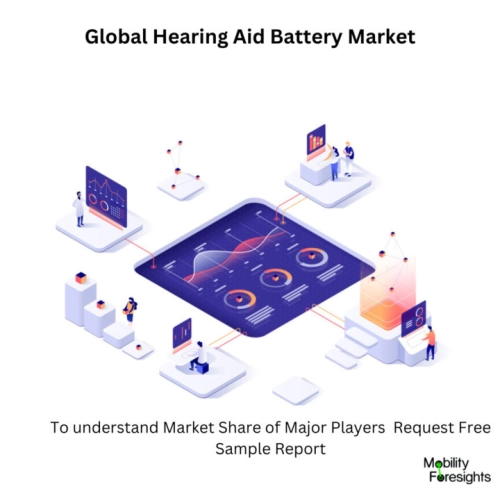
- Get in Touch with Us

Last Updated: Apr 25, 2025 | Study Period: 2024-2030
Zinc-air batteries are the most common type of hearing aid battery and are available in a variety of sizes. They are relatively inexpensive and have a long shelf life, but they must be replaced more frequently than other types of batteries.⯠The field of hearing aid battery technology is advancing rapidly. New developments in battery technology and hearing aid design are helping to make hearing aids more convenient, affordable, and efficient. This is making hearing aids more accessible to people with hearing loss.
Hearing aids, in particular, could greatly benefit from miniaturized solid-state batteries. These devices need to be small and lightweight for comfort, yet powerful enough to provide clear and consistent sound. The primary difference between disposable and rechargeable hearing aid batteries is that the latter can be recharged up to 500 times. Rechargeable batteries typically cost more than their disposable counterparts, but they last much longer and save money in the long-term.
Bluetooth hearing aids have become increasingly popular. Bluetooth hearing aids require more power than traditional hearing aids, which is driving demand for more powerful hearing aid batteries. Increasing technological advancements in Bluetooth hearing aids are creating new market growth opportunities.In the past, hearing aid batteries contained a little quantity of mercury to improve conductivity and stabilise the components inside. Other button cell batteries, such watch batteries, also contain mercury.
The mercury used in hearing aid batteries is thought by the general public to pose a risk to both the environment and people who use hearing aids.The selling of hearing aid batteries containing mercury is prohibited in some states. The majority of hearing aid battery producers have, however, voluntarily developed âzero-mercuryâ hearing aid batteries that function similarly to hearing aid batteries that contain mercury.

The Global Hearing aid batteryMarket accountedfor $XX Billion in 2023 and is anticipated to reach $XX Billion by 2030, registering a CAGR of XX% from 2024 to 2030.
Hearing aids are highly significant and helpful tools that enable millions of individuals to live full lives.New rechargeable hearing aid batteries are being developed with longer battery life. This is making rechargeable hearing aids more convenient and practical for users.New charging technologies are being developed that make it easier and faster to charge hearing aids. This is making rechargeable hearing aids more user-friendly. For example, some new charging cases can wirelessly charge hearing aids in under an hour.â¯
Solid-state batteries are a new type of battery that is still in development, but they have the potential to revolutionize the hearing aid battery market. Solid-state batteries are more energy-dense, have a longer lifespan, and are safer than traditional lithium-ion batteries.⯠New battery chemistries have the potential to improve the performance of single-use hearing aid batteries. For example, zinc-air batteries with new cathode materials have been shown to have higher energy density and longer lifespan.
Hearing aid batteries are typically single-use zinc-air batteries. This indicates that oxygen is necessary for the batteries to operate. â¯The batteries are packaged with a label or tab that, when removed, exposes tiny air-filled holes inside the battery.
| Company | Product | Year | Description |
| Rayovac | XCell | 2024 | Thsis batteries are formulated to provide quality performance over the life of the battery and deliver more power when needed. Hearing Aid Batteries are packaged in NEW certified Child Resistant packaging. |
| Akoio | Akoio's hearing aid battery dispenser | 2023 | It is a patented product that comes with six dispensers, each containing eight Size 312 batteries. The batteries are rust-proof and long-lasting, and the dispenser has a slot on the back for storing used batteries. |
| RCA | RCA RSH082 | 2024 | The RCA RSH082 comes equipped with Bluetooth streaming for audio, music podcasts, and phone calls (iOS and Android), along with advanced dual microphones for blocking out surrounding noise and frequency controls for volume settings for both indoors and outdoors. |
| RCA | RCA RSH053 | 2024 | It has an IP22 water-resistant design and comes with a 16-hour battery life and a USB-C recharging cradle with fast, two-hour charging. Its four-channel digital signal processing with noise reduction amplifies. |

| Sl no | Topic |
| 1 | Market Segmentation |
| 2 | Scope of the report |
| 3 | Abbreviations |
| 4 | Research Methodology |
| 5 | Executive Summary |
| 6 | Introduction |
| 7 | Insights from Industry stakeholders |
| 8 | Cost breakdown of Product by sub-components and average profit margin |
| 9 | Disruptive innovation in the Industry |
| 10 | Technology trends in the Industry |
| 11 | Consumer trends in the industry |
| 12 | Recent Production Milestones |
| 13 | Component Manufacturing in US, EU and China |
| 14 | Market Segmentation, Dynamics and Forecast by Geography, 2024-2030 |
| 15 | Market Segmentation, Dynamics and Forecast by Product Type, 2024-2030 |
| 16 | Market Segmentation, Dynamics and Forecast by Application, 2024-2030 |
| 17 | Market Segmentation, Dynamics and Forecast by Life-span, 2024-2030 |
| 18 | Product installation rate by OEM, 2023 |
| 19 | Incline/Decline in Average B-2-B selling price in past 5 years |
| 20 | Competition from substitute products |
| 21 | Gross margin and average profitability of suppliers |
| 22 | New product development in past 12 months |
| 23 | M&A in past 12 months |
| 24 | Growth strategy of leading players |
| 25 | Market share of vendors, 2023 |
| 26 | Company Profiles |
| 27 | Unmet needs and opportunity for new suppliers |
| 28 | Conclusion |